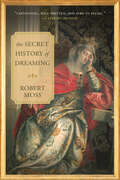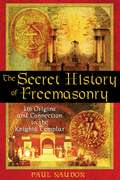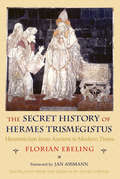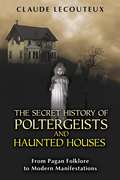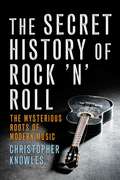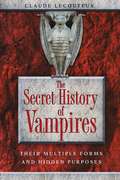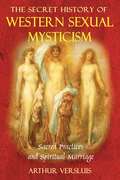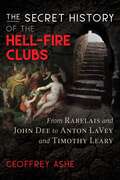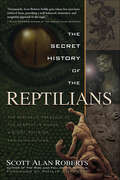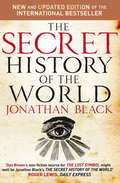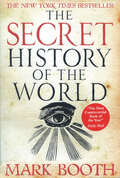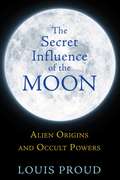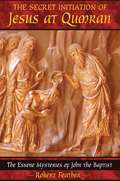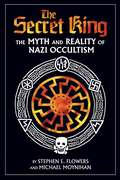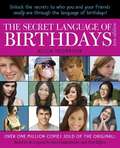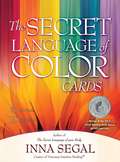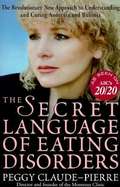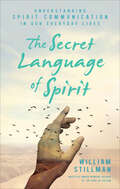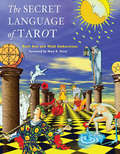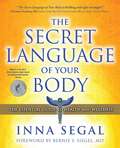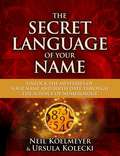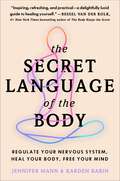- Table View
- List View
The Secret History of Dreaming
by Robert MossDreaming is vital to the human story. It is essential to our survival and evolution, to creative endeavors in every field, and, quite simply, to getting us through our daily lives. All of us dream. Now Robert Moss shows us how dreams have shaped world events and why deepening our conscious engagement with dreaming is crucial for our future. He traces the strands of dreams through archival records and well-known writings, weaving remarkable yet true accounts of historical figures who were influenced by their dreams. In this wide-ranging, visionary book, Moss creates a new way to explore history and consciousness, combining the storytelling skills of a bestselling novelist with the research acumen of a scholar of ancient history and the personal experience of an active dreamer.
The Secret History of Extraterrestrials: Advanced Technology and the Coming New Race
by Len KastenExplores the role of ETs in the military, government, technology, history, and the coming new age • Surveys contact with ETs, abductions, alien technology and exopolitics, genetic tampering by ETs, and the history behind the Nazis and UFOs • Contains interviews with Jesse Marcel, Michael Salla, Paul LaViolette, Robert Bauval, Helen Wambach, and others at the forefront of the ET-derived New Science movement The extraterrestrial presence on Earth is widening and, as we enter the Aquarian Age, will be admitted officially, causing shock and an urgent universal need to understand the social and technological changes derived from our space brothers. A primer for the explosive advances humanity will experience scientifically and spiritually in the coming years, this compendium explores the ET phenomenon and its influence on humanity past and present. The book surveys contact with ETs and abduction accounts, unexplained public and undisclosed military technology from aliens including anti-gravity devices, exopolitics (the influence of ETs in human affairs), the Iraqi Stargate, the Hybrid Project of alien interbreeding by abduction, Nazi ties to UFOS and their secret underground base in Antarctica, government cover-ups of alien interactions including Roswell, and the transformation triggered by the Hale-Bopp comet. Based on interviews with people who are witnessing the coming changes as well as those visionaries who are actually bringing them about--including John Mack, Major Jesse Marcel, Paul LaViolette, Robert Bauval, Michael Salla, and Helen Wambach--this book sketches out a breathtaking vision of the planetary revolution just around the corner.
The Secret History of Freemasonry: Its Origins and Connection to the Knights Templar
by Paul NaudonExplores the hidden history of Freemasonry from ancient Rome, through the Middle Ages, to the present• Shows the close connection between medieval masons and the Knights Templar• Illustrates the sacred nature of Roman and medieval trade associations• Reveals the missing link that connects the lodges of modern Freemasonry to the medieval brotherhoods of buildersHistorians often make a sharp distinction between the operative Masonry of the Middle Ages and the speculative Masonry of modern times, emphasizing that there is no direct bridge connecting the two. Modern historians also have scoffed at Masonic claims concerning the close relationship between the Lodge and the Temple. Using medieval archives housed throughout Europe, historian Paul Naudon reveals that there was in fact a very intimate connection between the Masons and the Knights Templar. Church records of medieval Paris show that most, if not all, the Masons of that time were residents of the Templar censive, which allowed them to enjoy great exemptions and liberties from both church and state as a result of the protection afforded them by this powerful order.Naudon shows that the origins of Freemasonry can be traced back to the collegia of ancient Rome. He traces the evolution of organizations such as the Comacine Masters, the Arab turuqs, and the brotherhoods of builders created under the aegis of the Benedictines and the Knights Templar, all of which provide the vehicle for the transmission of a sacred tradition from pre-Christian times to the modern era. This tradition is the source of Masonic ritual and symbolism, and it provides the missing link in the transformation of the operative Masonry of the medieval cathedral builders to the spiritual principles of modern speculative Masonry.
The Secret History of Hermes Trismegistus: Hermeticism from Ancient to Modern Times
by Florian Ebeling"Perhaps Hermeticism has fascinated so many people precisely because it has made it possible to produce many analogies and relationships to various traditions: to Platonism in its many varieties, to Stoicism, to Gnostic ideas, and even to certain Aristotelian doctrines. The Gnostic, the esoteric, the Platonist, or the deist has each been able to find something familiar in the writings. One just had to have a penchant for remote antiquity, for the idea of a Golden Age, in order for Hermeticism, with its aura of an ancient Egyptian revelation, to have enjoyed such outstanding success."—from the IntroductionHermes Trismegistus, "thrice-great Hermes," emerged from the amalgamation of the wisdom gods Hermes and Thoth and is one of the most enigmatic figures of intellectual history. Since antiquity, the legendary "wise Egyptian" has been considered the creator of several mystical and magical writings on such topics as alchemy, astrology, medicine, and the transcendence of God. Philosophers of the Renaissance celebrated Hermes Trismegistus as the founder of philosophy, Freemasons called him their forefather, and Enlightenment thinkers championed religious tolerance in his name. To this day, Hermes Trismegistus is one of the central figures of the occult—his name is synonymous with the esoteric.In this scholarly yet accessible introduction to the history of Hermeticism and its mythical founder, Florian Ebeling provides a concise overview of the Corpus Hermeticum and other writings attributed to Hermes. He traces the impact of Christian and Muslim versions of the figure in medieval Europe, the power of Hermeticism and Paracelsian belief in Renaissance thought, the relationship to Pietism and to Freemasonry in early modern Europe, and the relationship to esotericism and semiotics in the modern world.
The Secret History of Poltergeists and Haunted Houses: From Pagan Folklore to Modern Manifestations
by Claude LecouteuxWhat poltergeist accounts through the ages reveal about our own worldviews • Provides a wide array of case studies from ancient Greece and Rome to medieval Europe to the modern world • Explores the relationship between poltergeists and troubled adolescence • Looks beneath the Christian adulteration of pagan practices to reveal the hidden ancestral beliefs tied to poltergeists and haunted houses Stories of poltergeists and their mischievous and sometimes violent actions--knocking, stone or chair throwing, moving objects with invisible hands, and slamming or opening doors--are a constant through the ages. What changes is how we interpret this activity. For our pagan ancestors this phenomenon was caused by helper spirits whose manifestations revealed their unhappiness with a household. The medieval Christian church demonized these once helpful spirits and held exorcisms to expel them from the houses they haunted--which proved effective less than half the time. The Age of Enlightenment cast these incidents as clever hoaxes, and many still believe this today. But poltergeist manifestations continue to appear and often defy attempts to debunk them as pranks. What then is behind this phenomenon? Exploring accounts of poltergeists from ancient Greece and Rome, medieval Europe, and the modern world, Claude Lecouteux finds that while our interpretations of poltergeists may change, the manifestations always follow a similar course and evolution. He shows how modern scientific studies of poltergeist manifestations have found a strong tie between these visitations and the presence of a troubled adolescent in the house. Looking beneath the Christian adulteration of pagan practices to reveal the hidden ancestral beliefs tied to poltergeists and haunted houses, the author shows how these unhappy spirits serve as confirmation of the supernatural beings that share the earth with us and of our relationship with the natural and unseen world, a relationship we must take care to keep in balance.
The Secret History of Rock 'n' Roll
by Christopher KnowlesSex. Drugs. Loud music. Wild costumes. Dazzling light shows. These words can all describe a great rock concert or a hot dance club, but they were also part and parcel of the ancient cultural phenomenon known as the "Mystery religions." In this book, author Christopher Knowles shows how the Mystery religions got a secular reincarnation when a new musical form called rock 'n' roll burst onto the scene. The Secret History of Rock 'n' Roll traces the history of the Mysteries - their rise, their fall, and their survival through long centuries of repression. Knowles shows how the Mysteries prefigured subcultures as diverse as Santeria, Freemasonry, Mardi Gras and even the Holiness churches of the American frontier, and explains exactly how ancient rituals and music found their way to the New World. In the process, The Secret History of Rock 'n' Roll traces the development of rock's most popular genres such as punk and heavy metal, and reveals how many of rock's most iconic artists play the same archetypal roles as the ancient gods. You'll see how many of the rituals and customs and even musical styles of our postmodern society have stunning ancient parallels. You'll meet history's first pop
The Secret History of Rock 'n' Roll
by Christopher KnowlesSex. Drugs. Loud music. Wild costumes. Dazzling light shows. These words can all describe a great rock concert or a hot dance club, but they were also part and parcel of the ancient cultural phenomenon known as the "Mystery religions." In this book, author Christopher Knowles shows how the Mystery religions got a secular reincarnation when a new musical form called rock 'n' roll burst onto the scene. The Secret History of Rock 'n' Roll traces the history of the Mysteries -- their rise, their fall, and their survival through long centuries of repression. Knowles shows how the Mysteries prefigured subcultures as diverse as Santeria, Freemasonry, Mardi Gras and even the Holiness churches of the American frontier, and explains exactly how ancient rituals and music found their way to the New World. In the process, The Secret History of Rock 'n' Roll traces the development of rock's most popular genres such as punk and heavy metal, and reveals how many of rock's most iconic artists play the same archetypal roles as the ancient gods. You'll see how many of the rituals and customs and even musical styles of our postmodern society have stunning ancient parallels. You'll meet history's first pop
The Secret History of Vampires: Their Multiple Forms and Hidden Purposes
by Claude LecouteuxA look at the forgotten ancestors of the modern-day vampire, many of which have very different characteristics • Looks at the many ancestoral forms of the modern vampire, including shroud eaters, appesarts, and stafi • Presents evidence for the reality of this phenomenon from pre-19th-century newspaper articles and judicial records Of all forms taken by the undead, the vampire wields the most powerful pull on the modern imagination. But the countless movies and books inspired by this child of the night who has a predilection for human blood are based on incidents recorded as fact in newspapers and judicial archives in the centuries preceding the works of Bram Stoker and other writers. Digging through these forgotten records, Claude Lecouteux unearths a very different figure of the vampire in the many accounts of individuals who reportedly would return from their graves to attack the living. These ancestors of the modern vampire were not all blood suckers; they included shroud eaters, appesarts, nightmares, and the curious figure of the stafia, whose origin is a result of masons secretly interring the shadow of a living human being in the wall of a building under construction. As Lecouteux shows, the belief in vampires predates ancient Roman times, which abounded with lamia, stirges, and ghouls. Discarding the tacked together explanations of modern science for these inexplicable phenomena, the author looks back to another folk belief that has come down through the centuries like that of the undead: the existence of multiple souls in every individual, not all of which are able to move on to the next world after death.
The Secret History of Western Sexual Mysticism: Sacred Practices and Spiritual Marriage
by Arthur VersluisThe first book to reveal the history of Western sexual mysticism • Reveals the secret sexual practices that have been used since ancient Greece to achieve mystical union with God • Details the sects and individuals who transmitted the radical sexual practices that orthodox Christianity never completely silenced • Distinguishes between sexual magic and sexual mysticism Beginning with the ancient Greek Mystery traditions, Gnosticism, and the practices in early Christianity, Arthur Versluis uncovers the secret line of Western sexual mysticism that, like the Tantra of the East, seeks transcendence or union with God through sexual practices. Throughout antiquity, and right into the present day, sexuality has played an important, if largely hidden, role in religious traditions and practices. This includes not only Christian but also kabbalistic and hermetic alchemical currents of sexual mysticism, many discussed together here for the first time. In the Mystery tradition of hieros gamos (sacred marriage) and the Gnostic tradition of spiritual marriage, we see the possibility of divine union in which sexual union is the principal sign or symbol. Key to these practices is the inner or archetypal union of above and below, the intermingling of the revelatory divine world with the mundane earthly one. Versluis shows that these secret currents of sexual mysticism helped fuel the rise of the troubadours and their erotic doctrine, the esoteric teachings of Jacob Böhme in the late 16th century, the 19th-century utopian communities of John Humphrey Noyes and Thomas Lake Harris, the free love movement of the 20th century, and the modern writings of Denis de Rougemont and Alan Watts.
The Secret History of the Hell-Fire Clubs: From Rabelais and John Dee to Anton LaVey and Timothy Leary
by Geoffrey AsheAn exploration of the origins, influences, and legacy of the scandalous Hell-Fire Clubs of the 18th century and beyond • Reveals the club’s origins in the work of Rabelais and the magical practices of John Dee and how their motto, “Do What You Will,” deeply influenced Aleister Crowley • Explores the cross-fertilization of liberty and libertinage within these clubs that influenced both U.S. and French Revolutions • Examines the debaucherous activities and famous members of many Hell-Fire Clubs, including Sir Francis Dashwood’s Monks of Medmenham Mention the Hell-Fire Clubs and you conjure up an image of aristocratic rakes cutting a swath through the village maidens. Which is true, but not the whole truth. The activities of these clubs of upper-class Englishmen revolved around not only debauchery but also blasphemy, ritual, quasi-magical pursuits, and political intrigue. Providing a history of these infamous clubs, Geoffrey Ashe reveals their origins in the work of François Rabelais and the activities of John Dee. He shows how the Hell-Fire Clubs’ anything-goes philosophy of “Do what you will”--also Aleister Crowley’s famous motto--and community template were drawn directly from Rabelais. The author looks at the very first Hell-Fire Club, founded by Philip, Duke of Wharton, in 1720 and then at the Society of the Dilettanti, a fraternity formed in 1732. Ashe examines the life, travels, and influences of Sir Francis Dashwood, founding member of the Society of the Dilettanti and the scandalous Permissive Society at Medmenham, also known as the Monks of Medmenham. He also explores other Hell-Fire clubs the movement inspired throughout England, Scotland, and Ireland, including the violence-prone Mohocks and the Appalling Club. He shows how many illustrious figures of the day were members of these societies, such as Lord Byron. He also examines the rumors that Benjamin Franklin was a member, an allegation that can be neither confirmed nor denied. Exploring the political and magical ideas that fueled this movement, the author shows how the cross-fertilization of liberty and libertinage within the Hell-Fire Clubs went on to influence both the U.S. and French revolutions, as well as the hippie movement of the 1960s, the Church of Satan founded by Anton LaVey, and the motorcycle club known as the Hells Angels. The legacy of the Hell-Fire Clubs continues to impact society, beckoning both elite and outsider to cast aside social norms and “do what you will.”
The Secret History of the Reptilians: The Pervasive Presence of the Serpent in Human History, Religion and Alien Mythos
by Scott Roberts"Fortunately, Scott Roberts boldly goes where few men have surfaced from, providing a well-balanced, innovative, and insightful approach to the topic." —Philip Coppens, author of The Ancient Alien QuestionWhere the bloodlines of the Nephilim leave off, the real story just begins.Or does it go back even further than that?The very real probability that non-human intelligences visited and even copulated with primordial humans is detailed in civilization's most ancient cultural and religious records. These historical records further reveal that these intelligences were reptilian in nature--or, at the very least, have been represented throughout human history in reptilian form.From the Serpent, Nawcash, in the Garden of Eden; Atum, the Egyptian snake-man; and Quetzalcotl, the feathered serpent god of the Mayans to the double-helix snake symbol of Enki/Ea in ancient Sumerian literature, the serpent has been the omnipresent link between humans and the gods in every culture.In The Secret History of the Reptilians, Scott Alan Roberts investigates and examines the pervasive presence of the serpent in human history, religion, culture, and politics.Are we the product of an extraterrestrial race that moves and breathes--and even breeds--beneath the surface of all of human history?Put on your thinking cap and take an historical, anthropological, archaeological plunge into the heady waters of extraterrestrial origins.
The Secret History of the World
by Jonathan Black Quercus QuercusTHE INTERNATIONAL BESTSELLERThe complete history of the world, from the beginning of time to the present day, based on the beliefs and writings of the secret societies.Jonathan Black examines the end of the world and the coming of the Antichrist. Or is the Antichrist already here? How will he make himself known and what will become of the world when he does? Willl it be the end of Time? Having studied theology and learnt from initiates of all the great secret societies of the world, Jonathan Black has learned that it is possible to reach an altered state of consciousness in which we can see things about the way the world works that hidden from our everyday commonsensical consciousness. This history shows that by using secret techniques, people such as Leonardo da Vinci, Isaac Newton and George Washington have worked themselves into this altered state - and have been able to access supernatural levels of intelligence. This book will leave you questioning every aspect of your life and spotting hidden messages in the very fabric of society and in life itself. It will open your mind to a new way of living and leave you questioning everything you have been taught - and everything you've taught your children.
The Secret History of the World
by Mark BoothThis New York Times bestselling work reimagines world history though the belief systems of Freemasons, Rosicrucians, Kabbalists, and others.They say that history is written by the victors. But what if history as we know it written by the wrong people? What if everything we’ve been told is only part of the story? In this groundbreaking and controversial work, Mark Booth embarks on an enthralling tour of our world’s secret histories. Booth starts from a dangerous premise: That the stories put forward by the world’s various cults and mystical traditions are true. From there he relates a deeply provocative alternate history of the past 3,000 years. From Greek and Egyptian mythology to Jewish folklore, from Christian cults to Freemasons, from Charlemagne to Don Quixote, from George Washington to Hitler—Booth shows that history needs a revolutionary rethink, and he has 3,000 years of hidden wisdom to back it up.
The Secret Influence of the Moon: Alien Origins and Occult Powers
by Louis ProudThe Moon is not a cold, dead rock but a rich, fascinating world just as alive as Earth • Investigates the Moon as the home of an alien intelligence who controls humanity • Examines several of NASA’s Apollo missions and the findings they concealed • Reveals the many holes in the “Giant Impact” theory about the Moon’s origins and the evidence for a hollow, artificial Moon • Explores the deep influence of the Moon on the collective mind of humanity and occult teachings about the Moon from the Qabbalah, tarot, and other sources Despite being the most prominent celestial body after the Sun, the Moon has many qualities that science has yet to explain. Lunar rock samples reveal the Moon once had a magnetic field like the Earth, and seismic experiments by NASA suggest the Moon is at least partially hollow. For centuries people have observed lights, moving clouds and shadows, and even the disappearance of entire craters via telescope. Apollo astronauts repeatedly felt the presence of a “non-human intelligence” during their Moon visits, and many indigenous traditions speak of malevolent visitors from the Moon. A growing body of astrophysical and geological evidence shows the Moon is not an entirely natural world--that someone or something altered it long ago. Louis Proud explores the phases and movements of the Moon along with its ancient and mysterious features--its craters, maria, rilles, tunnels, and domes. He examines several of NASA’s Apollo missions, showing not that NASA faked the Moon expeditions but that they concealed what the astronauts found there. He explains the many holes in the commonly accepted “Giant Impact” theory of the Moon’s origins and reveals the evidence for a hollow, artificial Moon placed in orbit eons ago to observe Earth. Examining the deep influence of the Moon on the collective mind of humanity, Proud looks at what the Qabbalah, the tarot, and other occult traditions say about the Moon and interprets G. I. Gurdjieff’s teachings that “we are food for the Moon.” He investigates the Moon as a gateway to another realm, as the Purgatory of Christianity, and as the home of an alien intelligence who controls and exploits humanity. Examining the Moon from both scientific and esoteric perspectives, Proud shows the Moon is not a cold, dead rock but a rich, fascinating world just as alive as Earth.
The Secret Initiation of Jesus at Qumran: The Essene Mysteries of John the Baptist
by Robert FeatherAn examination of the early, mysterious Essene community at Qumran that links it with John the Baptist, Jesus, and the beginnings of Christianity• Offers an eyewitness account of the final burial place of John the Baptist• Makes the case that Christianity grew out of a form of monotheism first formulated by the Egyptian pharaoh Akhenaten• Includes physical and photographic evidence never before publishedIn his earlier book The Mystery of the Copper Scroll of Qumran, Robert Feather analyzed the Dead Sea Scroll engraved on copper that is considered the work of the secretive, devout Jewish sect known as the Essenes, who lived at Qumran around the time of Jesus. To continue his research into the Essene community's way of life and how its beliefs may have influenced the beginnings of Christianity, he met with Father Jozef Milik, one of the scholars who worked on deciphering the Dead Sea Scrolls in the 1950s. Feather learned that during Milik's work somewhere near the Qumran ruins, he had excavated a headless corpse that he believed to be that of John the Baptist. Feather presents persuasive, powerful evidence illustrating the strong link between the Qumran Essenes and New Testament teachings and showing that both John the Baptist and Jesus were intimately involved with this community at Qumran. He further supports the claim that early Christians continued a belief system centered on a form of monotheism first formulated by the Egyptian pharaoh Akhenaten and uniquely espoused by the Essenes at Qumran.
The Secret King
by Michael Moynihan Stephen E. FlowersThe Secret King is the first book to explode many myths surrounding the popular idea of Nazi occultism, while presenting the actual esoteric rituals used by Heinrich Himmler's SS under the influence of rune magician Karl-Maria Wiligut, the "Secret King of Germany." Stephen E. Flowers, PhD, is a prolific writer and translator in the fields of runology and the history of occultism. He is also the author of books on magical runic traditions under the pen name Edred Thorsson. Michael Moynihan co-authored the best-selling, award-winning book Lords of Chaos. He also co-edits the esoteric journal Tyr.
The Secret Language of Birthdays: Teen Edition
by Joost Elffers Gary Goldschneider Alicia ThompsonA teen version of the wildly popular adult book The Secret Language of Birthdays, this book provides astrological insight into the character of people born on each of the 365 days in the calendar year. It is the perfect gift item for birthday parties and sleepovers. This smart book is jam-packed with completely new content, including illustrations and unbelievably fun extras, with tips on everything from Best Accessory (Box of tissues for when your drama queen BFF starts crying!) and Best Pet (Puggle!) to the Best Date idea (hot air balloon ride). The teen version is colorful, dynamic, and totally addictive.
The Secret Language of Birthdays: Teen Edition
by Joost Elffers Gary Goldschneider Alicia ThompsonA teen version of the wildly popular adult book The Secret Language of Birthdays, this book provides astrological insight into the character of people born on each of the 365 days in the calendar year. It is the perfect gift item for birthday parties and sleepovers. This smart book is jam-packed with completely new content, including illustrations and unbelievably fun extras, with tips on everything from Best Accessory (Box of tissues for when your drama queen BFF starts crying!) and Best Pet (Puggle!) to the Best Date idea (hot air balloon ride). The teen version is colorful, dynamic, and totally addictive.
The Secret Language of Color eBook
by Inna SegalThe Secret Language of Color Ebook is your key to unlocking the extraordinary healing power of color. Featuring 45 stunning color images, each infused with a unique healing vibration and accompanied by a step-by-step healing exercise, author Inna Segal will assist you in adding more joy, harmony, and wellness to all areas of your life. With various creative ways to use the cards--including simply asking a question and picking an image that appeals to you, focusing a color on an area of the body that needs that color's particular healing attention, and color visualization--along with the aid of the color descriptions anyone can interpret and create useful practices of wellness. Each color's unique vibrations are there to explore, from silvers ability to strengthen your persistence, plum helping you to overcome challenges, burgundy to awaken passion, and emerald to create a calm, mind, body, and spirit, this vibrant and powerful ebook by Inna Segal is a tool anyone can use daily to receive inspired and intuitive messages of guidance and to restore their body to its natural state of balance and harmony.
The Secret Language of Eating Disorders
by Peggy Claude-Pierre"I feel so dirty, hopeless, no-good, fat, scared, a failure. I don't deserve to live. " "My daughter is 5'8" and 60 pounds. She won't comply with anyone. She has ruined the family. " "I can't be cured. I'm too bad. I'm going to have to deal with this the rest of my life. " "My doctor told me that I don't want to grow up. " "I hate myself for being the cause of all of this. " "I don't want my daughter to die. They say we are a dysfunctional family, but we don't fight and we love our daughter. Surely something can be done. " All of these statements are based on myths and misconceptions about anorexia and bulimia. Unfortunately, these myths and others not only deepen the suffering of victims of eating disorders, but shape how we regard and treat those victims. If you are a parent , family member, loved one, or caregiver of a victim, or a victim yourself, you know the punishing pain and sense of hopelessness caused by eating disorders. Now an extraordinary new book offers new hope and help to all whose lives are threatened by these scourges. In The Secret Language of Eating Disorders, Peggy Claude-Pierre, founder of the world-renowned eating disorders program at the Montreaux Clinic in Victoria, Canada, puts these damaging myths to rest and reveals her groundbreaking theories on the ultimate cure for illnesses that current medicine treats with little success. Peggy Claude-Pierre developed her unique insights into eating disorders through successfully treating her own two anorexic daughters and hundreds of acutely ill patients at Montreaux, which specializes in treating victims near death whom doctors and hospitals haven't helped. She became convinced that eating disorders stem from a complex negative mindset. Often established at birth, it causes sufferers to feel an overwhelming sense of worthlessness that frequently results in a slow process of self-destruction. It is Peggy Claude-Pierre's conviction that this mindset--and the resulting eating disorder--can be permanently reversed through a program based on unconditional love, regard, positive reinforcement, easing of the victim's burdens of blame and responsibility, and objectivity training. In The Secret Language of Eating Disorders, Claude-Pierre details her theories on the true causes of anorexia and bulimia and lays out the basis of the Montreaux program, which has an astonishingly high success rate, curing even the gravest cases. She describes the origins of the negative mindset and the five stages of recovery from eating disorders, spotlights the special challenges of coping with them at home, and offers clear, practical guidelines to working effectively with health professionals. She also shares the voices of dozens of former patients who offer their own stories of recovery as inspiration to victims, their families, and loved ones. Peggy Claude-Pierre's heartfelt message of hope is that eating disorders can be cured, not merely managed, and that deep within every person suffering from these illnesses is a loving, deserving soul who can and should be saved. As Peggy Claude-Pierre writes to victims, "You are not failures at life, merely at understanding your own value. Soon professionals across the globe will discontinue treating the symptoms of eating disorders as the cause. " This powerful, compassionate book will revolutionize the way we think about eating disorders and their victims. It will literally save lives.
The Secret Language of Spirit: Understanding Spirit Communication in Our Everyday Lives
by William Stillman“The Secret Language of Spirit is the result of many years of dynamic mediumship. It soars with hope and conviction.” —Whitley Strieber, #1 New York Times–bestselling authorThe Secret Language of Spirit is the culmination of award-winning author and psychic medium William Stillman’s wisdom and insights in a fascinating exploration of the sometimes blatant, sometimes hidden spiritual symbolism in our everyday lives. With accessible language, easy-to-understand explanations, and fascinating anecdotes, Stillman introduces to the open-minded layperson an alternate lens through which to view daily interactions with Spirit.Topics unique to this compelling new work include:A thorough explanation of Heaven’s inner workingsRecognizing Spirit-speak—the silent but ever-present signs and signals that surround usDecoding symbolic patterns found in nature, dreams, our names, and the manifestation of “threes”Associative links in memory that correlate spiritually to music and scentsStillman’s most powerful observations may be found in the chapter that correlates spiritual sensitivity with persons with autism, mental illness, and dementia—individuals whose “gibberish” is often dismissed as pathology but may actually provide glimpses into another realm.The Secret Language of Spirit concludes with an empowering chapter that addresses the concepts of abundance and achieving authenticity with Love’s Foot Rule—12 fundamental tenets. Stillman also introduces the principles of passion, pursuit, and prosperity, and how to manifest them in concert with Spirit.“Particularly illuminating are the connections he makes in the communications of people with dementia, mental illness and autism. This pioneering book offers insights that will both inform and inspire readers.” —Raymond Moody, author of Life After Life
The Secret Language of Tarot
by Ruth Ann Amberstone Mary Greer Wald AmberstoneSecret Language of Tarot sets itself apart from other tarot books by teaching readers how to translate the pictorial symbolism from one deck to another, strengthening the reader's ability to recognize specific icons in any deck and in the world around them. The Secret Language of Tarot can be used as both a reference book and as a series of guided meditations on the individual symbols. Each of the seven chapters contain a set of symbols that share a common theme. Extensive research provides readers with the lore and mythological meanings of the symbols to help foster intuitive powers. The explanation of imagery is both insightful and eclectic. When read from beginning to end, The Secret Language of Tarot reveals a hidden current of understanding and connection between the individual cards of the deck. Each chapter ends with an Integration Lesson and a special Symbol Spread to deepen the understanding of the cards. The Secret Language of Tarot brings imagery and intuition into a course of study of the tarot. It is a must-have for any serious tarot reader that is written in accessible language for the novice as well.
The Secret Language of Your Body: The Essential Guide to Health and Wellness (Essential Wellness Series)
by Inna SegalDiscover the groundbreaking bestseller and TikTok sensation that reveals the connection between your physical health and emotional well-being, and offers processes for healing—featuring a foreword by Bernie Siegel, M.D.Dive into the enchanting world of holistic healing with renowned intuitive healer Inna Segal. Digging into the root causes of over 300 symptoms and medical conditions, she lays bare the mental, emotional, and energetic triggers behind physical ailments. This comprehensive guide comes complete with a free thirty-five-minute audio download where Inna herself guides you into a powerful self-care and well-being journey, attuning you to the messages your body communicates. Venture into an empowering, transformative journey that calls upon your body&’s built-in ability to heal itself. With Segal's gentle guidance, you'll not only restore your physical self but also break free from the shackles of limiting beliefs and emotions that may be hindering your growth and vitality. Decode the secret language of disease, access quick and easy exercises for nurturing your organs, and use color to rejuvenate your life. By the end of this inspiring journey, you'll have uncovered and applied the life-altering teachings your body has been signaling you all along and be able to live the life you were truly meant to live.
The Secret Language of Your Name: Unlock the Mysteries of Your Name and Birth Date through the Science of Numerology
by Ursula Kolecki Neil KoelmeyerDo you truly understand your strengths and weaknesses? Are you living at your full potential? Could simply changing the spelling of your name alter your life? While most numerology books focus only on your birthday, The Secret Language of Your Name is the first comprehensive guide to incorporate an exploration of the letters of your name. With this extra step, you are given a unique, complete reading that reveals specific individual keys to success and happiness in all facets of life. Prepare to learn: * how to pinpoint your greatest strengths and weaknesses; * what makes friends, family, and coworkers tick; * how different spellings of your name can affect your future, even what happens when your name changes in marriage; * how to choose the best baby name--with numerical representations of nearly 5,000 names; * whom you are most compatible with in love and business; * how to choose an ideal career path; * and more! With each new challenge, you'll find yourself reaching again and again for this definitive guide.
The Secret Language of the Body: Regulate Your Nervous System, Heal Your Body, Free Your Mind
by Jennifer Mann Karden Rabin“Inspiring, refreshing and practical - a delightfully lucid guide to healing yourself.” –Bessel van der Kolk, MD., New York Times bestselling author of The Body Keeps the ScoreFrom two mind-body practitioners comes the new essential self-healing bible—a revolutionary body-first guide to reducing stress, resolving long-term pain, and healing from trauma for good using your body’s own nervous system.Your autonomic nervous system is responsible for the constant but mostly subconscious communication between your brain and body. When you experience stress, anxiety, or trauma, your nervous system formulates responses to keep you alive. But you can also become trapped in survival mode if you’re consistently exposed to unsafe environments, toxic relationships, or destructive thought patterns. When this happens it’s known as nervous system dysregulation or sensitization, which can result in chronic mental and physical pain and confusion, leaving you unable to cope with life’s strains and stresses.Mind-body practitioners Jen Mann and Karden Rabin, co-founders of the Chronic Fatigue School now provide the first in-depth look at nervous system regulation, somatic therapy, Polyvagal theory, the vagus nerve, and the mind-body connection. Combining science-backed insights and hands-on techniques, The Secret Language of the Body teaches you how to move out of survival mode, regulate your nervous system, and heal your mind and body. Rabin and Mann don’t teach stress management, but something far more powerful–how to control your body’s nervous system. With this revolutionary book, you will learn to skillfully speak the language of your body and train it to not only manage stress but achieve personal transformation.The Secret Language of the Body includes helpful illustrations.
